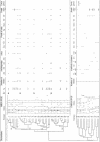Epidemiology and typing of Staphylococcus aureus strains isolated from bloodstream infections
- PMID: 15583295
- PMCID: PMC535234
- DOI: 10.1128/JCM.42.12.5650-5657.2004
Epidemiology and typing of Staphylococcus aureus strains isolated from bloodstream infections
Abstract
We carried out an epidemiological study covering 2,365,067 patient days of hospitalization between 2000 and 2003. During this time, 413 Staphylococcus aureus bloodstream infections occurred. This corresponds to 15% of the 2,676 bloodstream infections observed during this period in the 31 hospitals in our region of France, which has 2.5 million inhabitants. The incidence of nosocomial S. aureus bloodstream infections was 0.11 per 1,000 days of hospitalization. The prevalence of methicillin-resistant S. aureus (MRSA) strains, of which 13% were nonmultiresistant MRSA (NORSA), was 33%, and this percentage was stable over the 4 years. In contrast, the prevalence of S. aureus strains susceptible to methicillin but resistant to quinolones or susceptible to methicillin but multiresistant to antibiotics (EMSSA strains) increased from 4% in 2000 to 23% in 2003. As previously reported, MRSA strains were mostly recovered from nosocomial bloodstream infections, whereas NORSA strains-generally considered to be responsible for community-acquired infections-were always isolated from nosocomial bloodstream infections. Pulsed-field gel electrophoresis (PFGE) analysis of 109 MRSA strains and 15 EMSSA strains demonstrated clonal diffusion of the three major French MRSA clones and revealed considerable genetic heterogeneity among EMSSA strains. Although no epidemiologically related NORSA strains clustered in particular PFGE groups, the distribution of MRSA strains isolated from bloodstream infections according to the portal of entry (vascular devices, pulmonary, and urinary) was not random for the major PFGE clones, suggesting that each MRSA lineage displays particular virulence features.
Figures


Similar articles
-
Staphylococcus aureus strains isolated from bloodstream infections changed significantly in 2006.J Clin Microbiol. 2007 Mar;45(3):851-7. doi: 10.1128/JCM.02178-06. Epub 2007 Jan 24. J Clin Microbiol. 2007. PMID: 17251408 Free PMC article.
-
Are community-associated methicillin-resistant Staphylococcus aureus (MRSA) strains replacing traditional nosocomial MRSA strains?Clin Infect Dis. 2008 Mar 15;46(6):787-94. doi: 10.1086/528716. Clin Infect Dis. 2008. PMID: 18266611
-
Emergence of community-associated methicillin-resistant Staphylococcus aureus strains as a cause of healthcare-associated bloodstream infections in Korea.Infect Control Hosp Epidemiol. 2009 Feb;30(2):146-55. doi: 10.1086/593953. Infect Control Hosp Epidemiol. 2009. PMID: 19128184
-
The evolution of Staphylococcus aureus.Infect Genet Evol. 2008 Dec;8(6):747-63. doi: 10.1016/j.meegid.2008.07.007. Epub 2008 Jul 29. Infect Genet Evol. 2008. PMID: 18718557 Review.
-
New epidemiology of Staphylococcus aureus infection in Asia.Clin Microbiol Infect. 2014 Jul;20(7):605-23. doi: 10.1111/1469-0691.12705. Clin Microbiol Infect. 2014. PMID: 24888414 Review.
Cited by
-
Differences in humoral immune response between patients with or without nasal carriage of Staphylococcus aureus.Eur J Clin Microbiol Infect Dis. 2017 Mar;36(3):451-458. doi: 10.1007/s10096-016-2817-3. Epub 2016 Nov 4. Eur J Clin Microbiol Infect Dis. 2017. PMID: 27815779
-
Factors influencing the clinical outcome of methicillin-resistant Staphylococcus aureus bacteraemia.Eur J Clin Microbiol Infect Dis. 2012 Mar;31(3):295-301. doi: 10.1007/s10096-011-1310-2. Epub 2011 Jun 14. Eur J Clin Microbiol Infect Dis. 2012. PMID: 21667352
-
Identification and validation of clinical phenotypes in Staphylococcus aureus bloodstream infection and their association with mortality (FEN-AUREUS study).EClinicalMedicine. 2025 May 7;83:103240. doi: 10.1016/j.eclinm.2025.103240. eCollection 2025 May. EClinicalMedicine. 2025. PMID: 40630616 Free PMC article.
-
Prophages and adaptation of Staphylococcus aureus ST398 to the human clinic.BMC Genomics. 2017 Feb 6;18(1):133. doi: 10.1186/s12864-017-3516-x. BMC Genomics. 2017. PMID: 28166723 Free PMC article.
-
Evaluation of a new chromogenic medium for isolation and presumptive identification of methicillin-resistant Staphylococcus aureus from human clinical specimens.Eur J Clin Microbiol Infect Dis. 2006 Jun;25(6):407-9. doi: 10.1007/s10096-006-0144-9. Eur J Clin Microbiol Infect Dis. 2006. PMID: 16767492 No abstract available.
References
-
- Albertini, M. T., C. Benoit, L. Berardi, Y. Berrouane, A. Boisivon, P. Cahen, C. Cattoen, Y. Costa, P. Darchis, E. Deliere, D. Demontrond, F. Eb, F. Golliot, G. Grise, A. Harel, J. L. Koeck, M. P. Lepennec, C. Malbrunot, M. Marcollin, S. Maugat, M. Nouvellon, B. Pangon, S. Ricouart, M. Roussel-Delvallez, A. Vachee, A. Carbonne, L. Marty, V. Jarlier, and the Microbiology Surveillance Network of Northern France. 2002. Surveillance of methicillin-resistant Staphylococcus aureus (MRSA) and Enterobacteriaceae producing extended-spectrum beta-lactamase (ESBLE) in Northern France: a five-year multicentre incidence study. J. Hosp. Infect. 52:107-113. - PubMed
-
- Andersen, B. M., K. Bergh, M. Steinbakk, G. Syversen, B. Magnaes, H. Dalen, and J. N. Bruun. 1999. A Norwegian nosocomial outbreak of methicillin-resistant Staphylococcus aureus resistant to fusidic acid and susceptible to other antistaphylococcal agents. J. Hosp. Infect. 41:123-132. - PubMed
-
- Anonymous. 2003. Outbreaks of community-associated methicillin-resistant Staphylococcus aureus skin infections—Los Angeles County, California, 2002-2003. Morb. Mortal. Wkly. Rep. 52:88. - PubMed
-
- Blanc, D. S., C. Petignat, P. Moreillon, J. M. Entenza, M. Eisenring, H. Kleiber, A. Wenger, N. Troillet, C. Blanc, and P. Francioli. 1999. Unusual spread of a penicillin-susceptible methicillin-resistant Staphylococcus aureus clone in a geographic area of low incidence. Clin. Infect. Dis. 29:1512-1518. - PubMed
Publication types
MeSH terms
Substances
LinkOut - more resources
Full Text Sources
Medical
Research Materials

